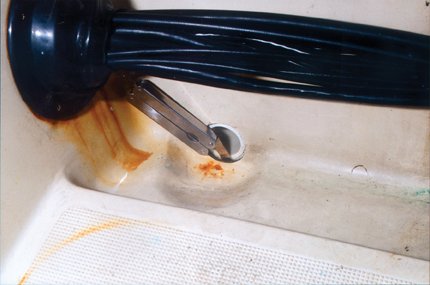Make sure your boating season doesn’t start with a thunk! The sound of your beloved hitting the bottom …
“I don’t know what happened; the boat was sitting there on the bottom of the slip. When they looked at it they said the battery was dead. Maybe the float switch got stuck.”
It doesn’t seem fair, but just as the boating season was about to get underway the skipper described above drove to his marina and found his 20′ runabout resting on the bottom. Not only did he have to start the boating season by filing an insurance claim (and paying the cost of the deductible), he probably had to wait until well into the season to begin boating because boatyards are slower to make unscheduled repairs during the spring outfitting rush.
Blaming a sinking on a float switch is like blaming your stomachache on a fork. True, bilge pumps can prevent a sinking, at least until the battery dies, but the real question in a sinking is, where did the water come from? More to the point, why didn’t someone visit the boat occasionally and check the bilges?
Tip
Before you kick off your boating season, make sure you download our great Spring Fitting Out Safety Checklist. It only take an hour or two to go through it all, and have peace of mind that everything’s in shipshape.
Advertisement
What The Heck Happened?
A seemingly simple problem like a slipped hose or an uncaulked drain can have huge repercussions and see your boat heading to the bottom. Most likely the boat pictured below sank when a hose that had been securely attached last season was taken off to winterize the engine. With all the attention going to the engine – Is pink stuff coming out the exhaust? – the hose clamp was overlooked. Here are five other possibilities:
Possibility #1

Heavy spring rains can get through poorly caulked ports, hatches, chainplates, and deck fittings. Water can “pool” on deck if scuppers become clogged by leaves in the fall, which then makes the problem worse. On many boats with low freeboard, the boat only needs to sink a few inches before outlets — scuppers and exhaust ports — become inlets.
Possibility #2
All too often, the owner is unaware of leaks because the automatic bilge pump dutifully kept the bilge dry during the warmer months. Over the winter, however, the battery — and the bilge pump — may go dead. With the pump knocked out and an owner who thinks the boat can take care of itself, water begins to accumulate. In this case, the boat sank because of a combination of heavy spring rains, a large open cockpit, and a deck drain that badly needed caulking.
Possibility #3

A poorly attached hose (secured with only one hose clamp) can be “lifted” off the seacock as the water freezes and expands. If a seacock is left open, water in the seacock and hose will freeze. As long as the water remains frozen, the boat will remain afloat. When the ice eventually thaws, the boat sinks. Seacocks should be closed over the winter or, in the case of cockpit drains, double-clamped securely with stainless-steel clamps. Note that the nipple in the photo isn’t barbed, which makes it that much more vulnerable.
Possibility #4
If water is left in the intake sea strainer, it can freeze and break the bowl. If the seacock is open, the boat sinks as soon as the ice thaws. If it’s closed, an unsuspecting owner may open the intake seacock in the spring without noticing the broken sea strainer. Check the sea strainer before you leave the boat!
Possibility #5

If a stuffing box isn’t tightened before the boat is laid up, even small amounts of water — a steady drip — can eventually swamp a boat. This could also happen over the summer, but it’s more likely in the winter and early spring because owners are more remiss about visiting their boats regularly. The lesson: Visit your boat routinely, regardless of the season.
NOTE: Never attempt to charge a frozen battery. To avoid explosion and serious injury, allow it to warm to 60°F (16°C) before charging.
